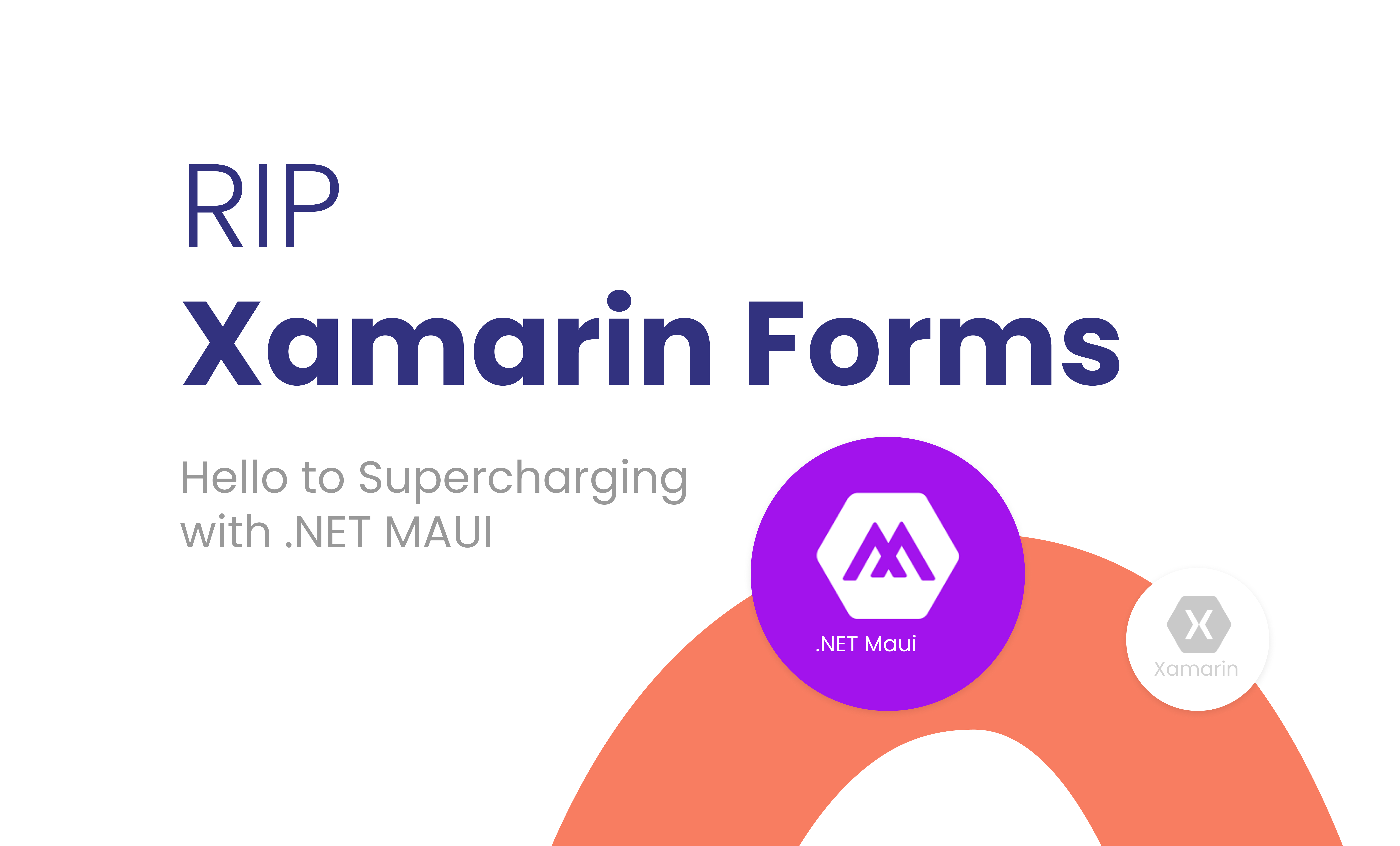
The inevitable: Xamarin migration to .NET MAUI
Xamarin Forms has been a popular choice for developers looking to create cross-platform mobile applications. However, with the recent news of Support for Xamarin Forms having a full shut down on May 1. 2024 and the announcement of Microsoft's new cross-platform framework, .NET Multi-platform App UI (MAUI), many developers are considering migrating to MAUI.


First, let's understand what
Xamarin Forms and MAUI are:
Xamarin Forms is an open-source UI toolkit that allows developers to create mobile applications for iOS, Android, and Windows using a single codebase. It uses the C# programming language and the .NET framework to build native user interfaces.
On the other hand, .NET MAUI is the next evolution of Xamarin Forms, which aims to provide a unified framework for building applications for all major platforms, including iOS, Android, macOS, and Windows.
With Xamarin Forms, developers had to write platform-specific code for certain features, which could be time-consuming and challenging. MAUI, on the other hand, provides a single codebase for all platforms, making it easier and faster to develop cross-platform applications.
Another significant advantage of MAUI is its support for the latest platform features. As technology evolves, mobile platforms are constantly introducing new features and capabilities that developers want to incorporate into their applications. With Xamarin Forms, developers are faced with the fact that support is fully shutting off.
See Microsoft's Xamarin support policy changes
With MAUI, developers will have access to the latest platform features as soon as they are released, allowing them to create more modern and feature-rich applications.
The rapid evolution of mobile app development demands strategic adaptability. With the Xamarin Forms end of life, a door opens to the future. This blog will explore the intricacies of migrating from Xamarin Forms to .NET MAUI, highlighting the substantial gains in performance, efficiency, and future-proofing for businesses venturing into this transformative journey.
Here are all the benefits of the
Xamarin to MAUI migration:
Optimizing Developer Resources: .NET MAUI
In the world of Xamarin Forms, cross-platform development often resembled an all-hands-on-deck endeavour. The transition to .NET MAUI, however, represents a paradigm shift. By consolidating cross-platform codebases, .NET MAUI transforms the development landscape. A single developer can now orchestrate what used to demand a larger team, streamlining the development process and reducing coordination overhead. Welcome to the era of the solo symphony in .NET MAUI!
This optimization not only accelerates development but also brings a significant shift in resource allocation.
Teams can now allocate resources more efficiently, focusing on innovation and creativity rather than navigating the complexities of managing diverse platforms. .NET MAUI sets the stage for a more agile and responsive development process, empowering developers to deliver high-quality apps with greater ease.

.NET MAUI with Blazor Integration for Unified Development
Xamarin is dead, and evolving into .NET MAUI, offers developers a seamless transition to a unified, modern ecosystem on the .NET 8 platform. One of the standout features is the integration with Blazor, a framework that enables developers to build interactive and dynamic web applications using C# and .NET. With this integration, developers can leverage a component-based architecture and C# for building both web and native cross-platform applications.
The synergy between .NET MAUI and Blazor significantly streamlines the development process. Developers can create reusable components that work seamlessly across both web and native applications, promoting code reuse and ensuring a consistent user experience.
This convergence not only enhances productivity but also encourages a unified approach to application development. Developers can leverage their existing skills in C# and .NET to create versatile and high-performance applications across different platforms.
Fast Track to Brilliance: .NET MAUI's Performance Leap
One of the most compelling reasons to transition from Xamarin Forms to .NET MAUI is the substantial performance enhancements that come with the upgrade. .NET MAUI's architecture serves as a speed optimization wizard, improving rendering, responsiveness, and overall efficiency.
Xamarin Forms laid a strong foundation, but .NET MAUI takes it to the next level.
Applications built with .NET MAUI exhibit a noticeable leap in performance, treating end-users to a smoother and more responsive experience. Whether it's handling complex animations, rendering graphics, or navigating through data-intensive processes, .NET MAUI proves to be a powerhouse in delivering top-notch performance.
This performance leap is not just about meeting current expectations but is forward-looking. As mobile devices continue to evolve, applications need to keep pace. Transitioning to .NET MAUI ensures that your app is not just up to speed but is prepared for the challenges of future technologies and user expectations.
Safe Harbor: Securing the Future with .NET MAUI
As Xamarin pivots towards .NET MAUI, the long-term support for Xamarin Forms gradually fades away. This shift brings forth a critical consideration – security. Migrating to .NET MAUI is not just a technical upgrade; it's a strategic move to secure the future of your applications.
By embracing .NET MAUI, businesses fortify their applications against emerging security threats. The ongoing support and updates provided by the .NET ecosystem ensure that your applications stay resilient to evolving security challenges. This forward-thinking strategy shields against vulnerabilities tied to stagnant or diminishing support for legacy frameworks.
The importance of security in the digital landscape cannot be overstated.
Cyber threats are ever-evolving, and applications must be equipped to withstand the challenges posed by malicious actors. .NET MAUI, with its commitment to ongoing support and security updates, provides a safe harbour for businesses seeking to protect their applications and user data.

So, how can developers migrate their existing Xamarin Forms projects to MAUI?
Microsoft has stated that they will provide a smooth migration process for Xamarin Forms projects to MAUI. This process will involve converting the current Xamarin Forms codebase to the new MAUI framework, which will be done automatically using migration tools.
However, depending on the complexity of the application, some manual adjustments may be required.
See Microsoft’s guide on how to successfully migrate from Xamarin to .NET MAUI
The move from Xamarin Forms to MAUI is an exciting development for cross-platform mobile application development. With MAUI, developers can expect a more streamlined and efficient development experience, access to the latest platform features, and a seamless migration process.
It is undoubtedly a future-proof choice for developers looking to create high-quality, cross-platform applications.
As a business you need to gear up for your app's stellar journey from Xamarin to .NET MAUI—it's like trading a bicycle for a rocket-powered scooter! With Elanwave, your seasoned navigators in all things migration, this odyssey is not just a transition but a tech spectacle.
The optimization of developer resources, integration with Blazor for unified development, the substantial performance leap, and the focus on future-proofing through enhanced security – these are the pillars that elevate .NET MAUI to the forefront of cross-platform mobile development.
Join the .NET MAUI party with confidence and security.
Ready for lift-off?
Elanwave, where expertise meets execution, ensures a smooth journey.
Each code line becomes a step towards app immortality.
Secure your seat for the ride where your app truly belongs! 🚀
Let's talk!


